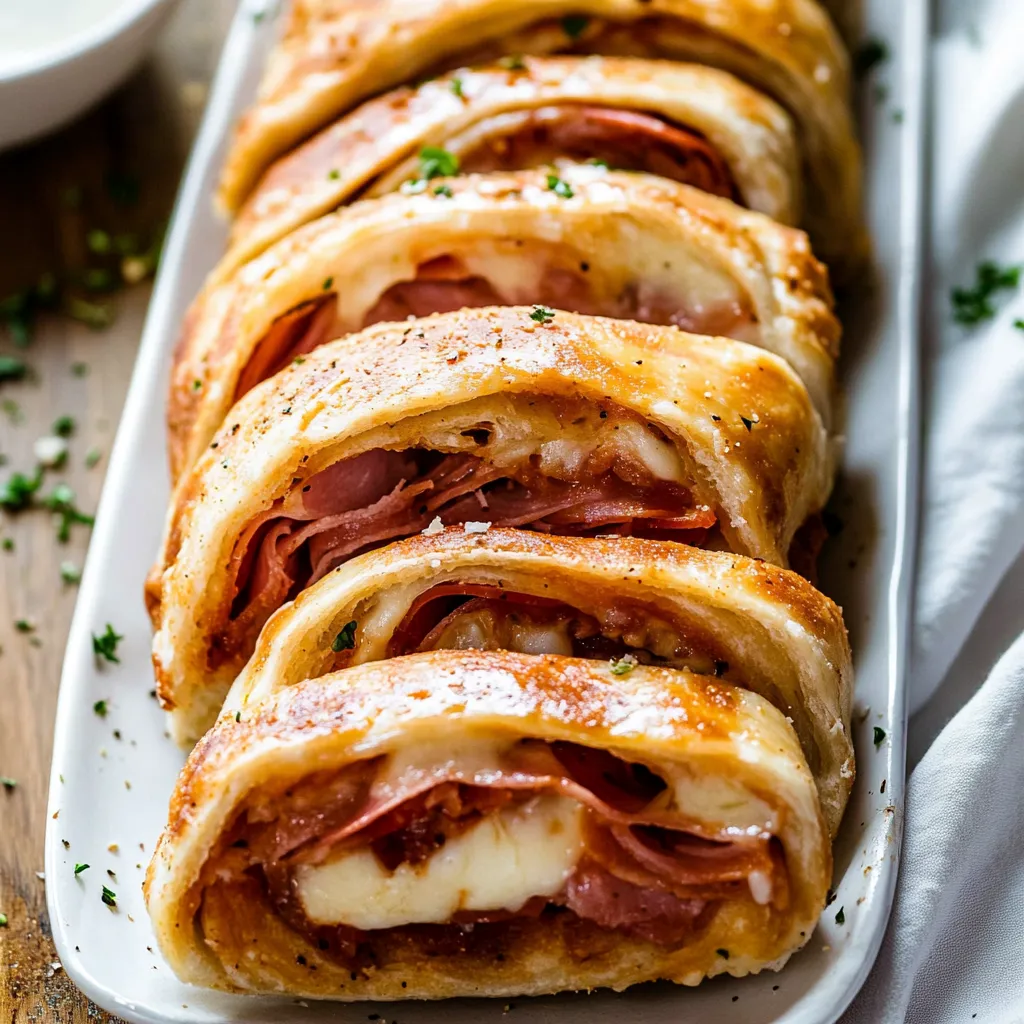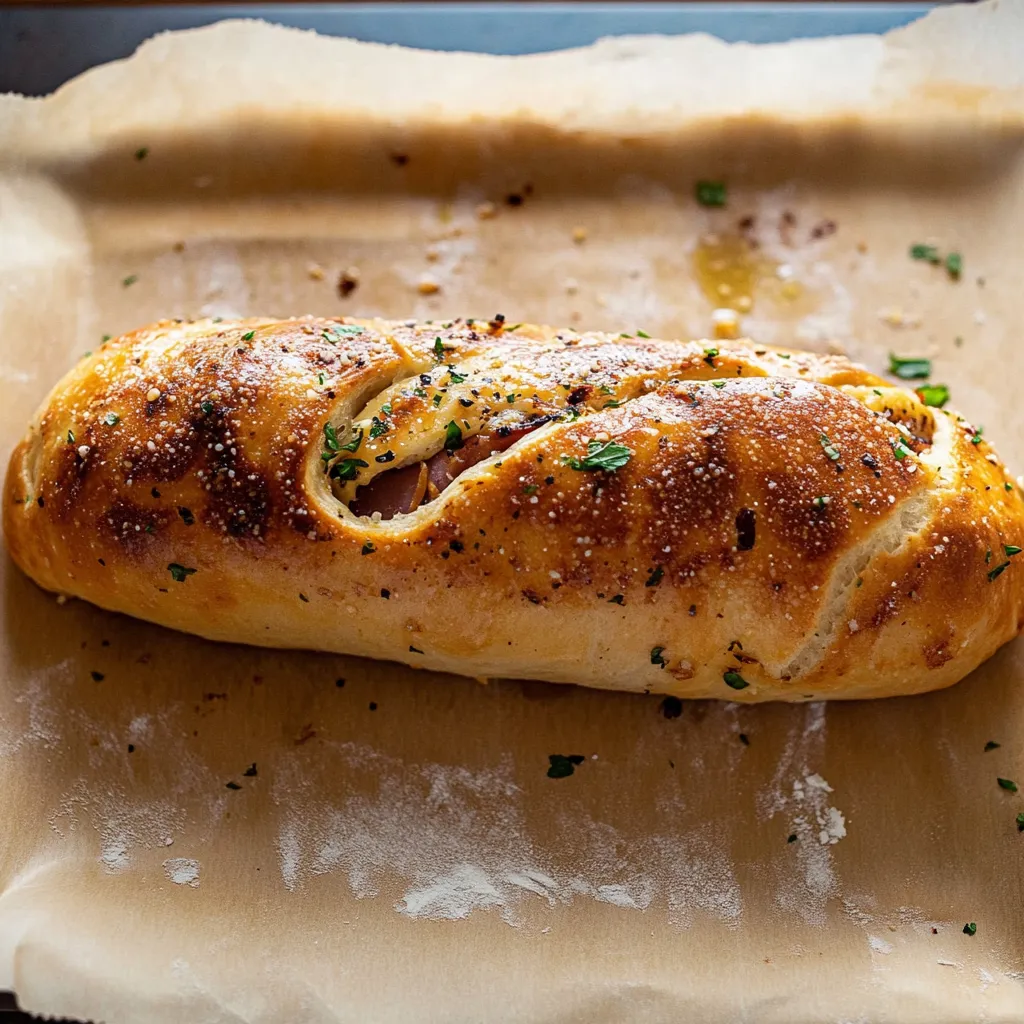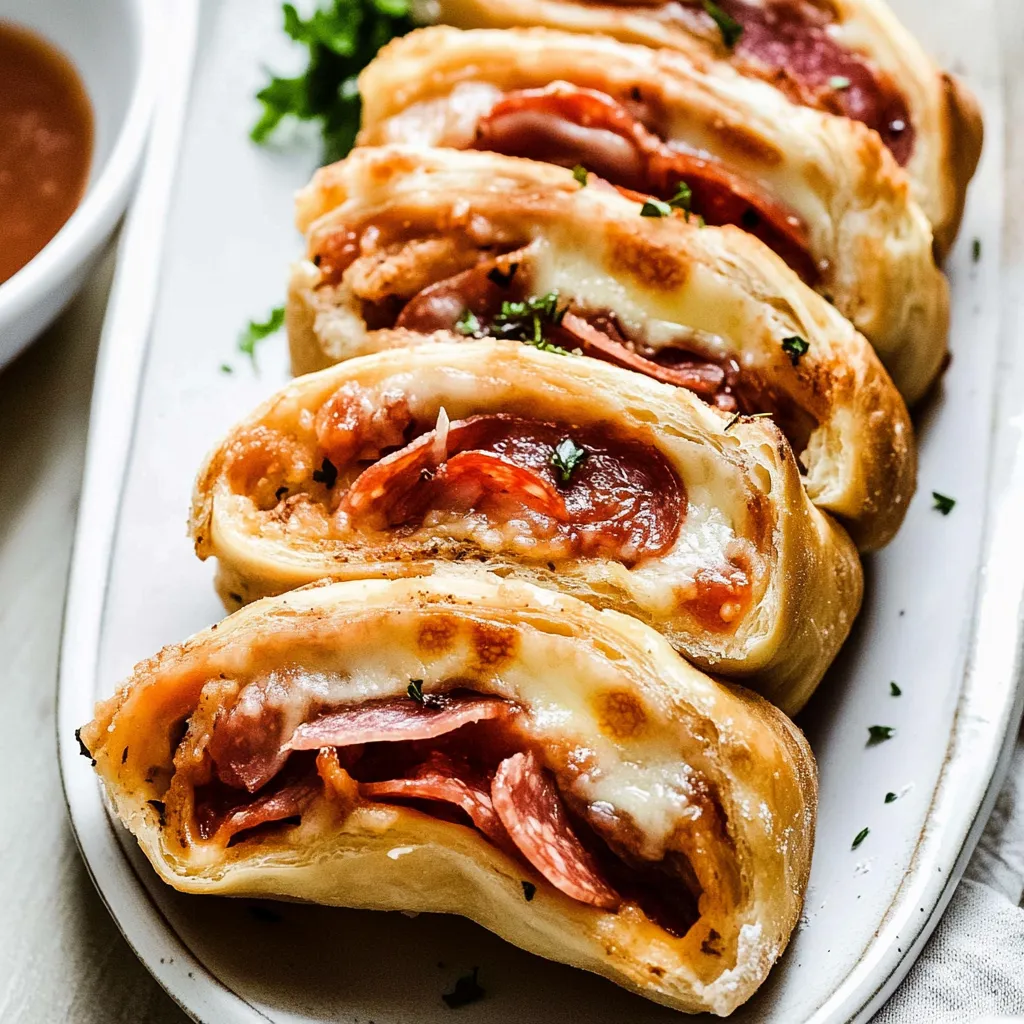 Pin it
Pin it
Rolling pizza dough around layers of meat and cheese creates something that tastes like a portable pizza you can slice and share. Homemade stromboli lets you stuff whatever combination of ingredients you want inside - pepperoni and mozzarella, ham and provolone, or even vegetables with multiple cheeses. The dough bakes up crispy on the outside while staying soft inside, and brushing it with garlic butter before filling adds flavor that makes every bite better. This works equally well as dinner for the family, an appetizer for parties, or game day food that disappears faster than you can slice it.
Stromboli became my solution for using up random deli meat and cheese sitting in the fridge drawer going stale. The first time I made it, I had four different cheeses, half a package of salami, and some pepperoni that needed using. Everything rolled together into something my family requested again the following week. Now I keep pizza dough in the freezer specifically for making stromboli on busy nights when I need dinner that feels special without requiring much effort. My kids love helping roll out the dough and arranging fillings, turning meal prep into an activity we do together instead of me working alone in the kitchen while they complain about being bored.
Ingredients and Why They Matter
- Warm water: 1½ cups, 110-115°F - Properly warm water activates yeast without killing it; too hot kills yeast while too cold won't activate it
- Active dry yeast: 2¼ teaspoons, one packet - Creates the rise and adds subtle yeasty flavor; instant yeast works as a direct substitute
- Granulated sugar: 1 tablespoon - Feeds the yeast and helps it activate faster while adding slight sweetness
- Olive oil: 2 tablespoons - Adds flavor and keeps dough tender; any neutral oil works if you prefer
- All-purpose flour: 3¾ cups, about 469 grams - Provides structure and chew; bread flour creates chewier texture while whole wheat makes denser dough
- Salt: 2 teaspoons - Essential for flavor and strengthening gluten structure in the dough
- Butter: 3 tablespoons melted - Brushed on dough before filling adds richness and helps other ingredients stick
- Garlic: 2-3 cloves minced - Mixed with butter for aromatic flavor throughout; garlic powder works in a pinch
- Fresh parsley: 2 tablespoons chopped - Adds fresh herbal notes; Italian seasoning or dried herbs substitute easily
- Deli meats: ½ pound per stromboli, about 20 slices - Salami, pepperoni, prosciutto, ham, or any combination you enjoy; use large deli-counter slices not small pizza pepperoni
- Cheese: ½ pound per stromboli - Provolone and mozzarella are classic; use 10-12 deli slices or 1½ cups shredded, or combine both
- Egg: 1 beaten for egg wash - Brushed on edges helps seal the dough and creates golden, shiny crust
- Coarse sea salt and black pepper: for topping - Adds visual appeal and enhances flavor on the baked crust
How To Make It
- Make the pizza dough:
- Pour warm water into a large mixing bowl and sprinkle the yeast over the surface. Add the sugar and stir gently, then let this mixture sit for about 5 minutes until it becomes foamy and bubbly on top. This proves your yeast is alive and active. If nothing happens after 5 minutes, your water was too hot or your yeast is dead - start over with fresh yeast and properly warmed water. Once foamy, add the olive oil, then stir in the flour and salt. Mix with a wooden spoon until a shaggy dough forms and no dry flour remains. Turn the dough out onto a lightly floured surface and knead for about 8-10 minutes until smooth and elastic. The dough should be slightly sticky but not wet, bouncing back when you poke it. If too sticky, add flour a tablespoon at a time. Place the kneaded dough in a lightly greased bowl, turning it once to coat all sides with oil. Cover with a damp towel or plastic wrap and let rise in a warm spot for 60-90 minutes until doubled in size.
- Prepare your fillings:
- While dough rises, get your fillings ready so everything is organized when you need it. Melt the butter and stir in minced garlic and chopped fresh parsley. Set this aside - you'll brush it on the rolled dough. Take out your deli meats and cheeses from the refrigerator so they come to room temperature, which makes them more pliable and easier to layer. If using vegetables, cook them now and blot away excess moisture with paper towels. Beat one egg in a small bowl for the egg wash. Line a large baking sheet with parchment paper or a silicone mat. Having everything prepped and within reach makes assembly quick and smooth.
- Divide and roll the dough:
- Once your dough has doubled, punch it down gently to release air bubbles. Turn it out onto a lightly floured surface and divide it in half using a sharp knife or bench scraper. Each half weighs about 1 pound. If you only want one stromboli now, wrap the second half tightly in plastic wrap and freeze for up to 3 months. For the half you're using, shape it into a rough rectangle by hand first, then use a rolling pin to roll it into approximately a 10x16 inch rectangle. The exact size isn't critical, but aim for relatively even thickness throughout. Roll from the center outward in all directions, turning the dough and adding flour underneath if it sticks. Don't stress about perfect edges - rustic works fine.
- Add the garlic butter and herbs:
- Use a pastry brush or spoon to spread your melted garlic butter mixture evenly over the entire surface of the rolled dough, going almost to the edges. Leave about a 1-inch border on three sides and a larger 3-inch border along one long edge - this gap is where you'll seal the stromboli closed. The butter creates a flavorful base layer and helps prevent the dough from getting soggy from cheese moisture. Sprinkle the parsley or other herbs evenly over the buttered surface. This herb layer adds color and fresh flavor to every bite.
- Layer meats and cheeses:
- Now comes the fun part where you build your filling. Start layering your meats across the dough, covering the buttered area but respecting those border spaces you left. Overlap slices slightly so there are no gaps. If using multiple meat types, layer them all. Place cheese slices or sprinkle shredded cheese over the meat layer, again covering everything except the borders. If using both sliced and shredded cheese, put sliced down first and shredded on top. Don't overstuff - more isn't always better because too much filling makes rolling impossible and causes leaking during baking. The recommended amounts work perfectly. If adding vegetables, layer them between the meat and cheese.
- Seal and roll tightly:
- Brush that 1-inch border around three sides and the wider 3-inch border along the top with egg wash using your pastry brush. The egg wash acts as glue that seals the dough closed. Starting from the bottom edge opposite the wide border, begin tightly rolling the dough up toward the top, like rolling a carpet or cinnamon roll. Roll slowly and keep tension firm so the log stays tight without any gaps or air pockets inside. When you reach the end, pinch that egg-washed border firmly onto the roll to seal completely. Tuck the ends under and pinch them closed too, sealing everything so no filling can escape. Carefully transfer the rolled stromboli seam-side down onto your prepared baking sheet.
- Apply egg wash and cut vents:
- Brush the entire surface of the stromboli generously with the remaining egg wash, coating the top and sides completely. This creates that beautiful golden, shiny crust during baking. Sprinkle the top with coarse sea salt, black pepper, and additional herbs if desired - these toppings are optional but add visual appeal and flavor. Using a sharp knife or razor blade, cut 3-4 diagonal slits across the top of the stromboli, cutting about ½ inch deep. These vents allow steam to escape during baking and prevent the stromboli from bursting open at the seams. Let the shaped stromboli rest on the baking sheet for about 15 minutes while your oven preheats.
- Bake until golden:
- Preheat your oven to 400°F while the stromboli rests. Once hot, slide the baking sheet onto the center rack and bake for 20-25 minutes. Watch through the oven window as it transforms - the dough will puff slightly, turn golden brown, and develop a crispy crust. You're looking for deep golden color all over, not pale yellow. The cheese inside will melt and might leak slightly through the vents or seams, which is normal and actually looks appetizing. When done, the stromboli should feel firm when gently pressed and sound hollow when tapped on the bottom.
- Cool and slice:
- Remove the baking sheet from the oven and let the stromboli cool for 5-10 minutes before slicing. This cooling time lets the cheese firm up slightly so it doesn't all run out when you cut into it. Use a sharp serrated knife to slice the log into 1-inch thick pieces, creating pinwheel slices that show off all your beautiful layers. Serve warm with marinara or pizza sauce for dipping. The crust will be flaky and crispy while the inside stays soft with melted cheese and flavorful meats throughout.
 Pin it
Pin it
Pizza dough became my most-used recipe after realizing one batch could turn into so many different meals. Making a full recipe and freezing half means I always have dough ready when I need it. My husband initially questioned why I bothered making dough from scratch when stores sell it, but after tasting homemade versus store-bought side by side, he understood the difference. Now he gets excited when he sees the mixer out because he knows something good is coming. Stromboli specifically reminds him of the pizza shop near his childhood home in Philadelphia, which makes this recipe extra special in our house.
The Importance of Proper Rising
Allowing dough to rise fully determines the final texture of your stromboli crust. Under-risen dough bakes up dense and heavy, lacking that light, airy quality good pizza crust should have. Properly risen dough that has doubled in size creates a tender interior with crispy exterior. The yeast needs time to produce carbon dioxide gas that creates air pockets throughout the dough. Rising in a warm environment speeds this process - try placing covered dough near a warm oven, on top of the refrigerator, or in a turned-off oven with just the light on. Cold kitchens slow rising significantly, sometimes requiring 2 hours instead of 90 minutes. Don't rush this step even though waiting is hard.
Rolling Technique Matters
How you roll the dough around the filling affects both appearance and eating experience. Rolling too loosely creates gaps where cheese pools and air pockets that leave empty spots. Rolling too tightly compresses everything so much that it tears the dough or squishes filling out the ends. The goal is firm, even tension from start to finish. Some cooks find it helpful to stop halfway through rolling and adjust the filling if things have shifted. Starting from the bottom and rolling toward the top wide border makes the sealing edge end up on top where it's easy to seal. Tucking ends under as you transfer to the baking sheet prevents filling from oozing out those sides.
Meat and Cheese Balance
Getting the filling ratio right prevents problems and ensures good flavor in every bite. Too much meat makes the stromboli heavy and greasy with not enough cheese to bind things together. Too much cheese creates a molten mess that leaks out everywhere and leaves you with mostly bread. The recommended ½ pound each of meat and cheese per stromboli represents the tested sweet spot. If you want to use multiple meat types, divide that ½ pound among them - maybe ¼ pound salami and ¼ pound pepperoni. Same with cheese - mix types but stay within the total weight. More isn't better here; it's just messier.
Vegetarian Adaptations
Creating meat-free stromboli that still tastes satisfying and substantial requires thoughtful ingredient choices. Use the full amount of recommended cheese since that becomes the main protein source. Add 2 cups of vegetables per stromboli, choosing lower-moisture options or cooking and draining wet vegetables thoroughly. Sautéed mushrooms add meaty umami flavor. Roasted red peppers contribute sweetness and color. Fresh spinach wilts into barely-there green specks. Caramelized onions bring depth. Roasted eggplant or zucchini bulk things up. Layer vegetables between cheese layers rather than putting them all in one spot. Season vegetables well since meat's saltiness is missing.
Freezing and Reheating
Both unbaked and baked stromboli freeze successfully for later meals. For unbaked, assemble completely, wrap tightly in plastic wrap and foil, label with baking instructions, and freeze for up to 3 months. Bake from frozen, adding 10-15 minutes to the baking time. For baked stromboli, cool completely, slice, wrap pieces individually in foil, and freeze. Reheat frozen slices at 350°F for about 15 minutes or microwave individual pieces for 1-2 minutes. Having frozen stromboli ready to bake or reheat makes weeknight dinners effortless. The dough freezes especially well - thaw frozen dough overnight in the refrigerator, then let it come to room temperature for 30 minutes before rolling.
Serving Suggestions
Stromboli works for various occasions depending on how you serve it. For dinner, slice into thick pieces and serve with marinara sauce for dipping, alongside a simple green salad. As an appetizer, cut into thinner slices and arrange on a platter with sauce in the center for easy grabbing. For game day, slice and keep warm in a slow cooker or chafing dish. Pack whole slices in lunchboxes where they tastes good at room temperature. The versatility makes this worth having in your regular rotation.
 Pin it
Pin it
This stromboli recipe represents the kind of cooking I find most satisfying - taking simple ingredients and basic techniques to create something that tastes homemade and special. The process of rolling dough around whatever fillings sound good feels creative rather than following rigid instructions. When you pull a golden, crispy log from the oven and slice into it to reveal those beautiful spiral layers, it looks like something from a bakery. Everyone gathering around to grab slices while they're still warm, dipping them in sauce and going back for more, creates exactly the kind of food memories worth making. Sometimes the best recipes are the ones flexible enough to change based on what you have and what you want, which describes stromboli perfectly.
Frequently Asked Questions
- → Can I make stromboli ahead of time?
- Yes, you can shape the stromboli and keep it in the fridge for up to 8 hours before baking. You can also freeze the dough for up to 3 months or freeze the shaped stromboli before baking.
- → What's the difference between stromboli and calzone?
- Stromboli is rolled like a log and sliced into pieces, while calzone is folded in half like a pocket. Stromboli usually has more layers of filling and is great for sharing.
- → What meats work best in stromboli?
- Italian cold cuts like salami, ham, capicola, and large pepperoni slices work great. Use about half a pound of sliced deli meat per stromboli for the best results.
- → Can I make vegetarian stromboli?
- Absolutely! Skip the meat and use cooked mushrooms, peppers, broccoli, or spinach instead. Just make sure to blot any excess moisture from the vegetables before adding them.
- → How do I store leftover stromboli?
- Wrap leftover stromboli tightly and store it in the fridge for up to 3 days. You can reheat slices in the oven at 350°F for about 10 minutes until warmed through.
- → Why do I need to cut slits in the top?
- The slits let steam escape while baking, which prevents the stromboli from getting soggy inside and helps the crust stay crispy.
